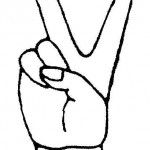How The Peace Sign Is Embedded In War
The peace sign is really represented in two distinct fashions. The first is the actual sign, rooted in pagan practice and roman polytheistic doctrine.
The original peace sign lacked the circle around it. It was called a "Nero's cross" and would often be used by Roman Legionnaires as brooches or insignias on their shields to show their enemies that resistance was futile and anyone that resisted would be crucified. This was literally the case in many famous and documented excursions into Judea. There, Christ was crucified by soldiers of the Nero cross. So how did something rooted in such violence become a peace sign? Well… that we can’t tell you for sure.

Nero's Cross
Let’s move on to the second image that we can immediately recognize as a symbol of peace. After all, aren't symbols worth a million words?
The second symbol that comes to mind is definitely the V shape with the pointer and middle finger! Indeed… this is reminiscent of the hippie era right? Getting high off bongs and chilling all day, screw war, screw political ideology, nothing better than relaxing all day.
 But did you know that this was the most famous symbol for continuing the withering war effort of Great Britain against Nazi Germany?
But did you know that this was the most famous symbol for continuing the withering war effort of Great Britain against Nazi Germany?
Indeed, the famous Winston Churchill himself came up with this one. He called it his "V for victory" And every time a city would get bombed, he would be there, in the rubble, giving this famous symbol. Rather than using it to promote peace, Churchill simply used it to keep his people in the mood to continue the war –remembering that at this point every citizen of London had lost 1 or more significant others-.
V , in statements recorded by citezens of London , was a statement of "keep fighting on to victory!". It was a defiance to the destuction of the great cities , no ammount of bombing by the legendary Luftwaffe could break the spirits of an englishman. One man even noted how uplifting it was to see a Churchill himself standing in the rubble , smoking his legendary cuban cigar. It made some even note him as almost invincible the shadows of defeat. Perhaps "in the shadows of defeat , the british emerge victorious?".
We for one wouldn't have minded meeting Churchill in person He sounds like a really interesting guy.





Conclusion: everything appears to be rooted in violence. Perhaps psychologically these became symbols of peace because it brought people together, in hopes of besting the cause. Not caving against overwhelming odds, and simply chilling while your cities burn, or your men are straight up on crosses. After all, weren’t the saints themselves martyr? And does war and tragedy not bring men together regardless of class, gender or occupation?
When you subscribe to the blog, we will send you an e-mail when there are new updates on the site so you wouldn't miss them.

